|
In the 16th century Sweden tried to gain the control of the
trade in the Baltic sea district. Therefore, in addition to the cities of Turku,
Viipuri and Porvoo, Helsinki and Tammisaari were founded on the southern coast
of Finland.
Finland took part in many wars along with Sweden against
Denmark, Russia and Poland. soldiers were accomodated in peasant houses,
encampments. When soldiers looted food from houses, in 1596, the peasants rose
in a rebellion against the governor of Finland, Klaus Fleming, his soldiers,
Finnish Nobility and tax collectors. Finally the peasants were defeated in this
so called "peasants' rebellion" named after clubs and maces they used as weapons.
About 3000 peasants died in the war.
|
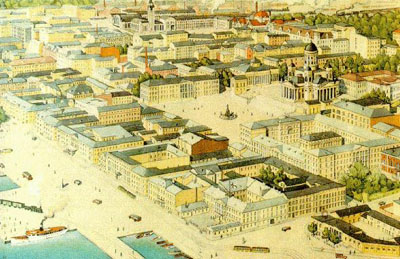 |
|
Helsinki Center in
the beginning of 20th century |
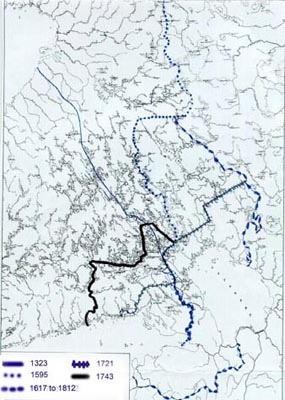
Former Eastern Boundaries of
Finland (Sweden-Finland),
Southern Section |
In the beginning of the new era Finland exported fur and
tar. Tar became the most important export product, because it was needed for
the surfaces of ships. There wasn't much industry during the Swedish regime.
People lived in class society, but there were a lot of
those, too, who didn't belong to any Estate. Those outside the Estates
didn't have the opportunity to deal with the affairs of the country in the
Diet. The King called in the Diet when he wanted and he was the only one who
could make a motion there. The present Parlament is the equivalent of the
former Diet.
In 1630's a Swedish member of the Nobility, Pietari Brahe,
became the governor of Finland. He succeeded in making many renovations ,
e.g. he founded four coastal towns and the first inland towns in Finland. He
paid attention in the brists of schools and tried to make them better.
Thanks to Pietari Brahe Turku got its own Academy in 1640. During the
administration of Pietari Brahe the living conditions got a lot better in
Finland.
|
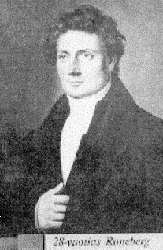
J.L. Runeberg.The writer of "Vδnrikki
Stoolin tarinat" ,
a story about the Great Nothern War |
In 1700 there broke a war between Sweden and Russia, "The
Great Northern War". During the years from 1714 to 1721 Finland was
occupied by Russians. This time is called Period of Great Hate. In the peace
treaty made in Uusikaupunki Finland lost some territory to Russia.
As a result of the lost war in 1730's there were born two
parties with different opinions, the Hats and the Bonnets. The
Bonnets wanted good connections with Russia, but the Hats tried to make
friends with the enemies of Russia. The situation became bad in 1771 when
Sweden declared so called "The war of Hats" against Russia.
Sweden lost the war however and had to give Russia some more territory of
Finland in the peace treaty made in Turku. In Tilsit in 1807 the French
Emperor Napoleon I and the Emperor of Russia, Alexander I made a pact that
Russia would press Sweden to join a commercial blocade against England. The
situation led into a war between Sweden and Russia (1808-1809) which is
called "The Finnish War" Russia occupied Finland again and
in the peace treaty made in Hamina Finland was incorporated into Russia. |
Already before the peace the Emperor of Russia Alexander I
called in the Finnish Diet in Porvoo in March 1809.
The first Finns
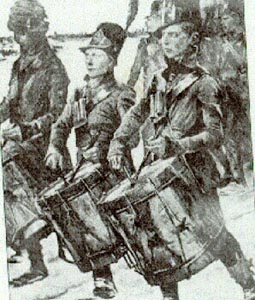 First people who
inhabited the area now called Finland were hunters and fishermen. Around 1500 BC
people began gradually to use bronze. At the same time in the western Finland
and in the inland people started to grow corn. People began to consider the land
as theirs and abodes became permanent and of better quality. Around 500 BC
agriculture became the principal industry. Finns exchanged furs and fish for
salt, weapons, jewellery and fabric with foreigners.
First people who
inhabited the area now called Finland were hunters and fishermen. Around 1500 BC
people began gradually to use bronze. At the same time in the western Finland
and in the inland people started to grow corn. People began to consider the land
as theirs and abodes became permanent and of better quality. Around 500 BC
agriculture became the principal industry. Finns exchanged furs and fish for
salt, weapons, jewellery and fabric with foreigners.
The bodies of the dead were burnt and the ashes were spread on
a hill and the belongings of the dead were placed in a tomb which was covered
with stones. About 3000 of these so called piles of glacial boulders have been
found in Finland.
Between 1155 and 1293 three crusades took place to Finland,
western Finland, Hδme and Karelia. As a result Sweden and Novgorod concluded
peace in Pδhkinδsaari in 1323 and Finland got its first border. This way most
Finns were left within the pale of the Roman Catholic church and Finland was
made a part of Sweden. Christianity was settled and the Bishop of Turku acted as
a spiritual leader and sometimes also as a temporal leader. During this time the
four Estates: the Nobility, the Clergy, the Burgesses and the Peasants were born.
In the Middle Ages the northern countries were united into
Kalmari Union which caused many conflicts, until so called "Sweden-Finland" was
taken apart from the Union under the leadership of Kustaa Vaasa, who was elected
the King of Sweden in 1523. Under the era of Kustaa Vaasa a Lutheran reformation
took place in Finland. It was caused by Mikael Agricola, former student of
Martin Luther. He created Finnish literary language and published the first
Finnish speller, ABC book. He also translated The New Testament into Finnish.
| People practised agriculture a lot
and in the 18th century proceeded from strip reparceling to general
reparceling |
 |
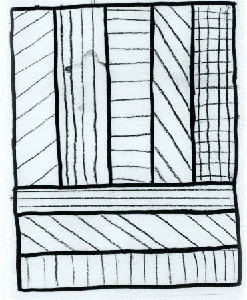 |
| General reparceling :
People got more land to their use in the same field area, so the field
work, especially harvesting, got easier |
Strip reparceling :
a big field was divided into smaller parts and every house got its own deal. |
Becoming independent
In the late 19th century Russians were not pleased with the
special position of Finland. To fulfill the Russification a Russian called N. I.
Bobrikov was nominated in 1898 the governor of Finland. His goal was to unite
monetary and customs intitutions, to take Russian language into use in every
Finnish governmental institution and also to open the Russians a chance of
holding posts in Finland. Finns wanted to appeal directly to the Emperor himself
so that he should put an end to the program. In a week 523 000 Finns had signed
the appeal and a delegation of 500 people left for St Petersburg to take this
appeal, "The Great Petition", to the Emperor. The Emperor didn't accept
them.
Governor Bobrikov was considered
the main responsible for oppression, so in 1904 an official of Senate Eugen
Schauman shot him. After the murder he shot himself believing he could make up
for the crime with his life.
When in 1905 there began a general strike in Russia in 1905,
also all Finns started striking to restore the autonomy. To end the strike the
Emperor gave a declaration according to which autonomy was restored in Finland
and Russification measures ended. One result was also that the Diet was given up
and replaced with Parliament. All 24-year-old citizens got the right to vote,
women as well as men, and all were equal. Finnish women were the first in Europe
to get the right to vote and so in 1907, when the Parliament gathered for the
first session, there were also 19 women among the representatives.
The oppression went on, however, and so during World War I
some young men got the idea that Finland should become independent. Some men
left Finland for Germany to get military education; they were called jaegers.
The revolutions in Russia in 1917 offered a chance of becoming
independent. After the October revolution the Finnish Parliament took superior
power to itself and put up a government, the object of which was to make the
country independent.
The government gave The Declaration of Independence on 6
December 1917, the day which is now celebrated as the Independence day.
After becoming independent it was discussed in Finland, if
there should be a king or a president ruling in Finland. At first Finland was
going to become a kingdom, but a German, Friedrich Karl, who was planned to
become the king, refused to take the position, because the Germans lost World
War I.
Time of independence
 |
In 1919 Kaarlo Juho Ståhlberg
was elected the first president of Finland. During his era of administration
Finland and Sweden started to argue about Åland. The case was taken to
League of Nations, which considered that Åland is a part of Finland.
Lauri Relander became
president in the 1925 elections. He travelled a lot and therefore got a
nickname "Reissu-Lasse".(Larry the traveller). During the administration of
Relander, in the late 1920's the extreme conservative movement grew stronger
and joined Lapua movement. Lapua movement was dissolved in the middle of
1930's, because it endangered democracy.
|
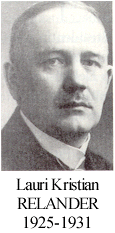 |
 |
The president at the time, P.E. Svinhufvud pushed
forward the dissolving.
In August 1939 Germany and the Soviet Union made a
nonaggression pact. It said that Finland belongs to front circle of the
Soviet Union. In the beginning of autumn 1939 the Soviet Union started
claiming territory of Finland, but Finland didn't agree and so the Soviet
Union attact Finland on 30 November 1939. Finns fought bravely and gained
many victories, but couldn't resist the great attack of the Soviet Union on
the Karelian Isthmus in 1940, in which over a milloin Russians took part. So
in truce on 13 March 1940 in Moscow Finland lost the Karelian Isthmus, the
territory of Lake Ladoga, a part of Salla-Kuusamo region and some smaller
areas.
|
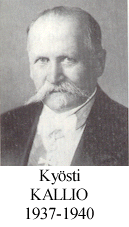 |
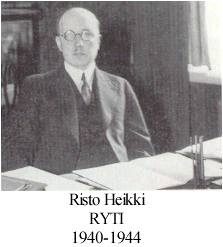 |
Finns wanted to take back the lost land and believed that
Germany would help in fulfilling this dream. On 22 June 1941 Germany
declared that Finland was fighting along with it against the Soviet Union.
Finland prepared for continued war better than for winter war and occupied
quickly the lost land. The attack ended in the late 1941 and stabilized war
began. It ended in June 1944. After the Normandy descent began a great
attack of the the Soviet Union troops on the Karelian Isthmus. Finland had
to give up and agree to make peace. In truce on 19 September Finland had to
give back the land it had occupied and in addition to them, Petsamo area. To
get peace president Risto Ryti had to resign and he was replaced with
Carl Gustav Emil Mannerheim. Finland had also to pay considerable
amount of war indemnity. In the late 1940's and in the early 1950's Finns
had a period of crisis, because the war indemnity had to be paid and
inhabitants from the lost land had to be settled in. |
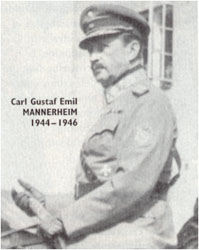 |
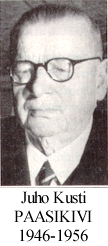 |
In 1946 J.K. Paasikivi was elected the president.
He started creating connections with the Soviet Union. In 1948 Finland and
the Soviet Union made YYA-pact, according to which Finland should protect
its territory, if somebody tried to attack the Soviet Union through Finland.
In 1955 the Soviet Union gave Finland back Porkkala naval base to show
friendship. Relations were becoming warmer. The same year Finland was
accepted as a member of UN. Soon after that Finland joined also the Council
of Nordic countries, which pushed forward cooperation between northern
countries; e.g. free travelling without passports.
|
 |
Further the relations were pushed forward by Urho
Kaleva Kekkonen, who was elected president in 1956. He has acted as
president for the longest time of all, because he was so popular as well in
Finland and in foreign countries. In 1961 Finland became an outer member of
EFTA. Kekkonen deserves credit for Finland being the host country of ETY-conference
in 1975.
In 1982 Mauno Koivisto was elected president
after Kekkonen had resigned for health reasons. After a year YYA-pact was
prolonged until 2003, but it was called off after the Soviet Union had
broken down.
Urho Kekkonen died in 1986. In the late 1980's Finland
began to get closer to Europe. It joined many organizations, among others EN
and in 1995 EU.
|
 |
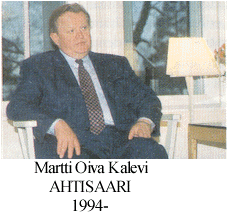 |
In 1994 Martti Ahtisaari was
elected president. Now Finland is planning to join EMU and some people have
talked about joining the NATO.
UP
|
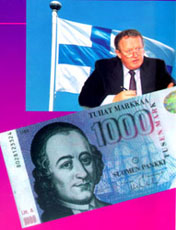 |